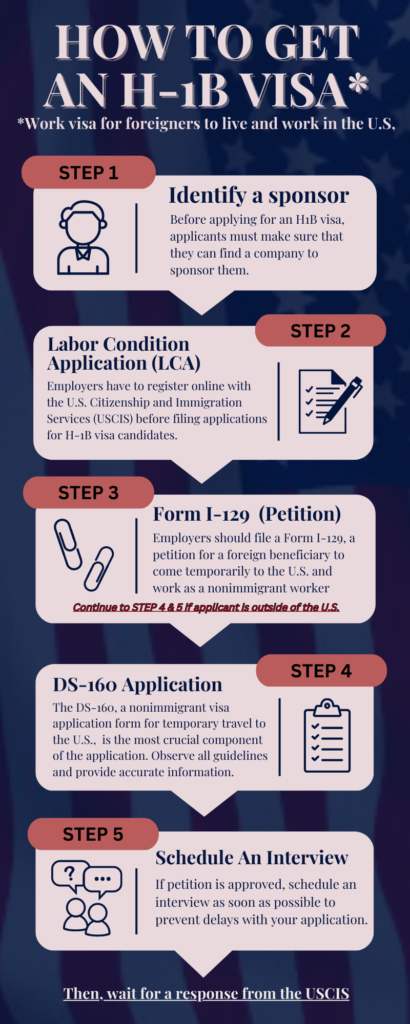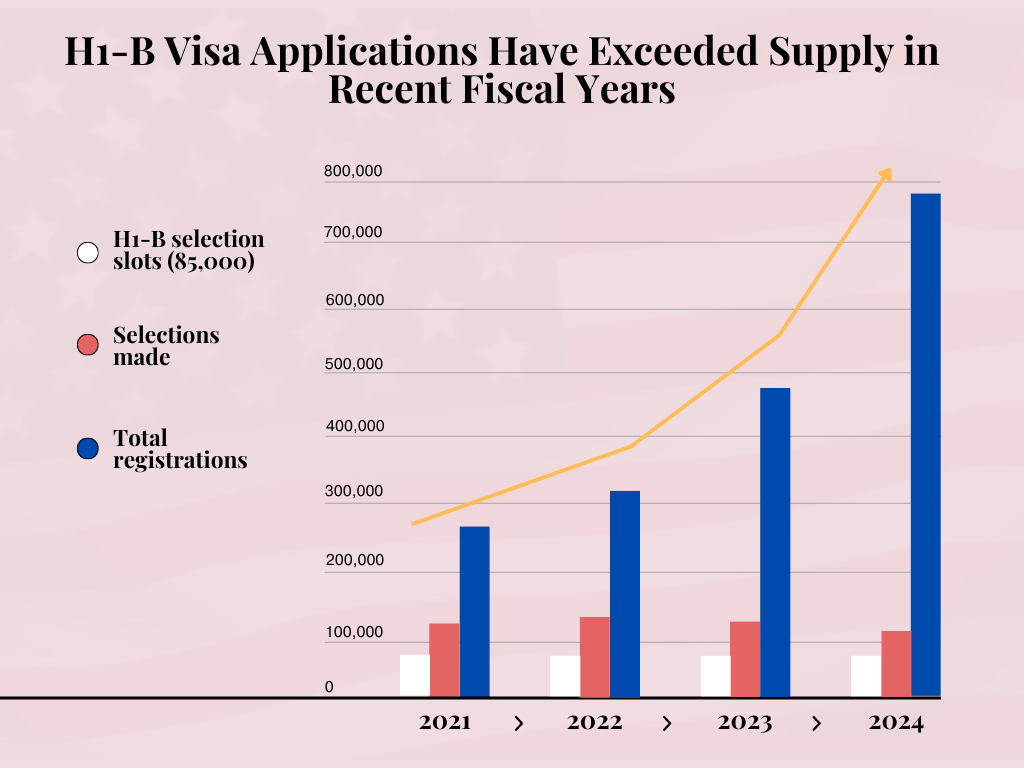Digital Package


Since the late 1800s, the United States of America has been perceived as the land of opportunity. Many come here in pursuit of a better life, but it was because of this desire and an influx of immigrants that the United States government had to place restrictions on those who could come and live in the country. Thus, immigration practices were made and refined, and eventually, the H-1B visa category was created in 1990. Under the H-1B temporary visa category, employers may petition for educated foreign professionals to work in jobs that need at least a bachelor’s degree or the equivalent. Up until 2005, with the exception of 1999-2003, only 65,000 slots were available for applicants to be selected for further processing. This was known as the H-1B Cap. Starting 2006, 20,000 additional slots were made for individuals who graduated with a master’s degree or higher from a U.S. institution of higher learning. Once approved, the H-1B visa is valid for three years, with the possibility of extension for up to six years.


The process to obtain one of these temporary work visas is very extensive and requires a lot of documents. For starters, applicants need to find a U.S. employer who is willing to sponsor them and this task alone is a challenging one. If they do manage to find one, employers must file a Labor Condition Application (LCA) with the U.S. Department of Labor. This application certifies that the employer will pay the employee the prevailing wage for the position and that hiring a foreign worker will not negatively impact the working conditions of U.S. workers.
After the LCA is certified, the employer must file the Form I-129, a petition for a foreign beneficiary to come temporarily to the U.S. and work as a nonimmigrant worker. This petition includes various documents such as the employee’s job offer letter, educational credentials, and evidence of work experience. The United States Citizenship and Immigration Services (USCIS) will review the petition and either approve or deny it. The employee then can apply for an H-1B visa at a U.S. consulate or embassy in their country. If the employee is outside of the U.S., they will need to file a DS-160 application which will allow them to travel to the United States if their H-1B visa is approved. Lastly, they will need to attend a visa interview at the U.S. consulate or embassy. During the interview, a consular officer will ask them questions about their background, qualifications and the purpose of their trip to the United States.
Despite having to go through this extensive process, a visa cannot be guaranteed for every applicant. Each fiscal year, there are only 85,000 slots for an individual’s application to be reviewed, with 20,000 reserved for those with a graduate degree from a U.S. educational institute. Almost every fiscal year, the number of applicants during the registration window exceeds the number of available slots. Thus, the United States government conducts an H-1B visa lottery. The lottery will determine which applications will be processed, so the H-1B visa application is not on a first-come, first-serve basis. The government usually conducts lotteries in multiple stages, typically making around 40,000 more selections than the allowed 85,000.

However, it is important to note that not all 85,000 will receive a visa approval. Their applications will still have to go through extensive processing and each year’s acceptance rate depends on the number of applicants, economic policies in place and the state of the economy among others. For instance, the denial rate between the 2016 and 2020 fiscal years was around 10-24%, but for the 2021 and 2022 fiscal years, they were 4% and 2% respectively. Successful applicants are subsequently informed of their status and encouraged to submit their complete H-1B petition within 90 days after notification. Each fiscal year, the number of applications submitted increases exponentially, from 274,237 in the 2021 fiscal year to 780,884 in the 2024 fiscal year. This lowers an applicant’s chances of getting an H-1B visa despite the acceptance rates being higher. There are a lot of hurdles that come with getting an H-1B visa. Therefore, applicants are encouraged to apply 6 months before their work start date. If they have done everything right, the rest is up to their chances of being selected.


View Putcha Sastry’s Immigration Story

Sources
- Anderson, S. (2023, February 7). New USCIS Data Show H-1B Denial Rates Remain Low. Forbes. https://www.forbes.com/sites/stuartanderson/2023/02/07/new-uscis-data-show-h-1b-denial-rates-remain-low/?sh=10ca02e738c7
- Kumar, Prathi, Andy, Kris, Jcp, j, Dreamer, U., Sai, Tuku, Desai, S., Deepak, Skmu, Vishnu, Kiran, Vishnu, h1, frustrated, Praveen, B., M., SivaRamaKrishna, … H1B. (2022, November 13). USCIS received 484k H1B registrations for h1b 2023 lottery. RedBus2US. Retrieved May 3, 2023, from https://redbus2us.com/uscis-received-484k-h1b-registrations-fy-2023/
- Library of Congress. (n.d.). Immigration to the United States, 1851-1900 : rise of industrial america, 1876-1900 : U.S. history primary source timeline : classroom materials at the Library of Congress : library of Congress. The Library of Congress. Retrieved May 3, 2023, from https://www.loc.gov/classroom-materials/united-states-history-primary-source-timeline/rise-of-industrial-america-1876-1900/immigration-to-united-states-1851-1900/#:~:text=In%20the%20late%201800s%2C%20people,the%20land%20of%20economic%20opportunity.
- U.S. Citizenship and Immigration Services. (2023, April 28). H-1B Electronic Registration process. USCIS. Retrieved May 3, 2023, from https://www.uscis.gov/working-in-the-united-states/temporary-workers/h-1b-specialty-occupations-and-fashion-models/h-1b-electronic-registration-process
- Upadhye, N. N. (2021, April 1). H-1B visa lottery (how does it work?). NNU Immigration. Retrieved May 3, 2023, from https://www.nnuimmigration.com/h1b-visa-lottery/
- Yekrangi & Associates. (2022, February 8). H-1B Visa Application Process [Infographic]. Yekrangi & Associates. https://www.yeklaw.com/blog/2022/february/h-1b-visa-application-process-infographic-/
